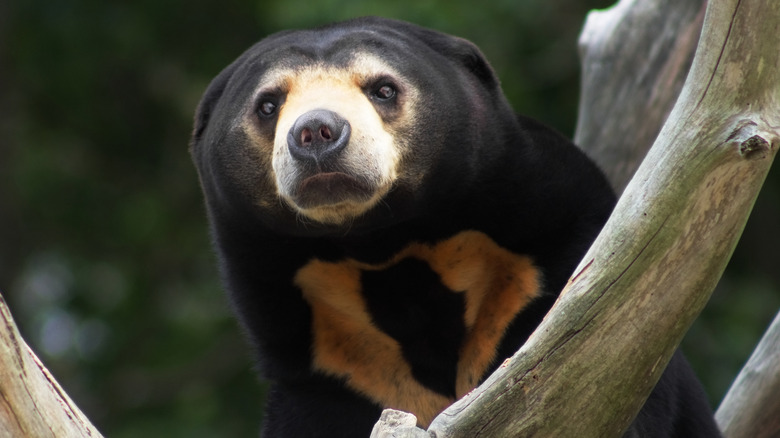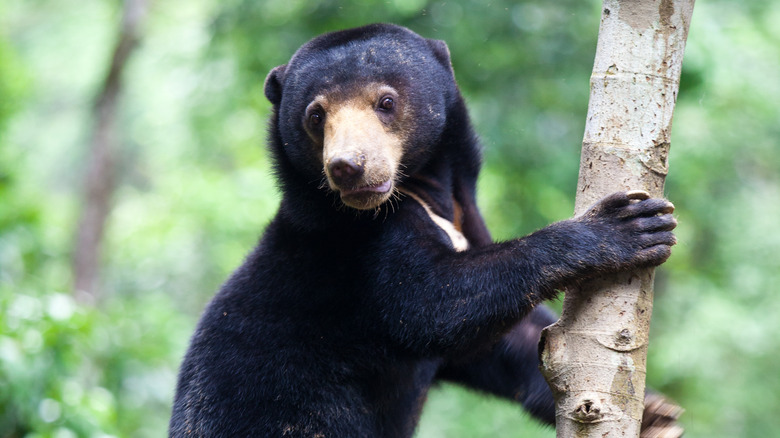What Is A Sun Bear And How Are They Different Than Other Bears?
Per National Geographic, as of 2023 eight bear species live on Earth. The smallest among them is the sun bear, native to Southeast Asia. Sometimes called "dog bears," in summer 2023 this bear species was in the news when footage shared online depicted a sun bear in its enclosure standing on its hind legs in a person-like fashion at Hangzhou Zoo in China. Some claimed it might not be a bear at all but a human dressed up like a sun bear, instead, CNN reports.
Zoo officials denied those accusations. Interestingly, the very same traits that make sun bears distinct from other bear species contributed to the confusion. Typically, sun bears are about the size of a large dog or a small person, at around 4 to 5 feet in length and weighing up to 150 pounds. Most notable of all those differences, though, sun bears — sometimes called Malayan sun bears — are observed in the wild not just standing but walking on their hind legs. Females sometimes even carry their cubs like a human mother.
On the Hangzhou Zoo sun bear controversy, wildlife biologist and Bornean Sun Bear Conservation Centre (BSBCC) founder, Wong Siew Te told CNN, "Most bear species can stand on their hind legs but sun bears stand up high to reach higher ground to investigate their surroundings so there is a purpose to why they do that. Female sun bears even hold their cubs with both hands and walk on their feet, very human like, so I guess that's why people get mistaken."
They live much of their lives up in trees
Another difference in the species is that sun bears live much of their lives up in trees. Except for polar bears, most bears climb, as North American Nature points out, but few live tree-based lifestyles quite like the sun bear, partially explaining their smaller-than-average size and shape. Sun bears even sleep among the branches, eating termites and honey with their long, skinny tongue, gathered by their longer-than-average claws. Based on that diet, another sun bear nickname is "honey bear" — eat your heart out, Pooh bear.
Sun bears are also most often nocturnal — yet another difference from their bear cousins, which are typically diurnal or switch back and forth depending on the season. As it stood up, the sun bear at Hangzhou Zoo did appear to be wearing a baggy costume on its lower half, but according to sun bear expert Wong Siew Te, that's also just another part of sun bear physiology. Their predators include snakes, tigers, and large birds of prey, and as a defense mechanism, sun bear skin is extra thick.
On the hind-end skin folds seen on the Chinese zoo sun bear, Ashleigh Marshall of the Chester Zoo in the U.K. added (via Today), "The extra skins are a really important adaptation for sun bears," and it evolved that way to avoid predators. And as Wong explained to CNN, "When conditions are bad and food is scarce," that extra-thick skin becomes loose.
Sun bears are threatened
One trait that sun bear share with their relatives, the species is highly threatened. Like many other animal species, deforestation has greatly affected the sun bear, but so too has the controversial bear bile trade. For centuries, bear bile has been used in Chinese medicine to treat or cure a number of ailments, per Animals Asia, and many sun bears are captured or bred in captivity so their gall bladder bile can be drained for this purpose. It is primarily moon bears — or the Asiatic black bear — that fall victim to the practice.
Farmers living alongside sun bears also sometimes kill them as they threaten their crops and livestock. On that note, wildlife biologist Wong Siew Te said (via CNN) "Not enough people know about sun bears — they are a very forgotten species. There needs to be more awareness and education about sun bears — they are a protected and special species and are in serious trouble." According to Today, attendance at the Hangzhou Zoo shot up as people flocked to see the purported fake sun bear for themselves (pictured above).


